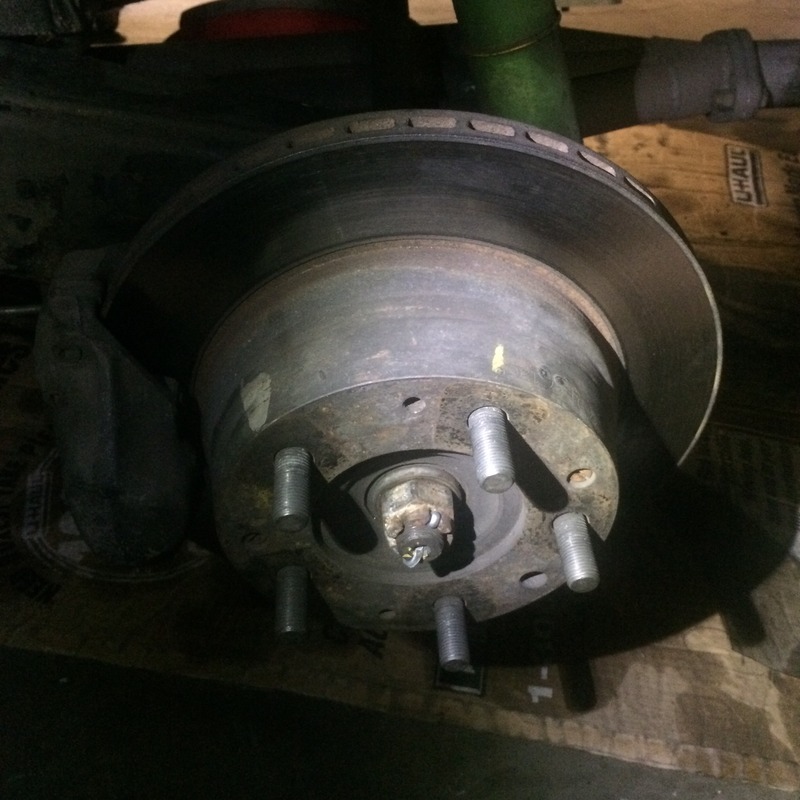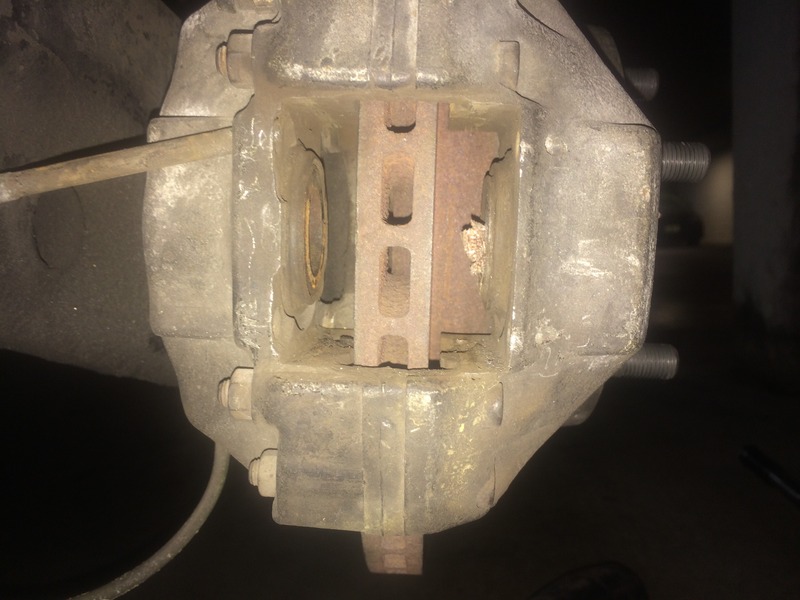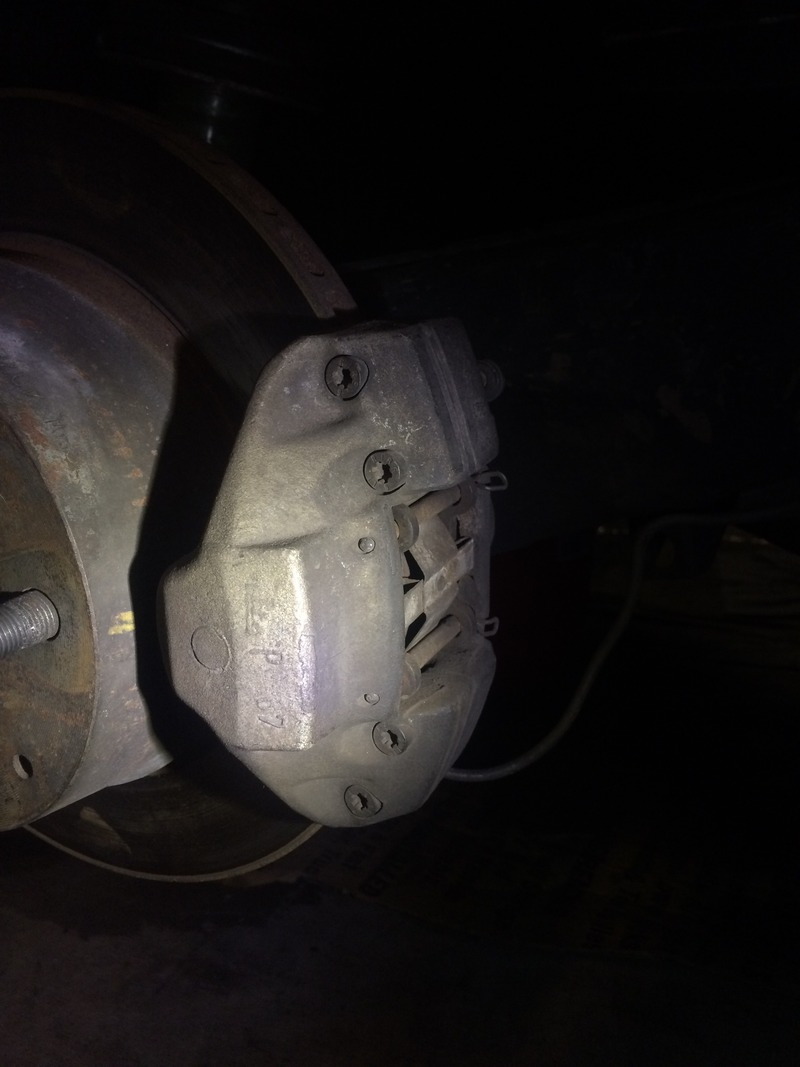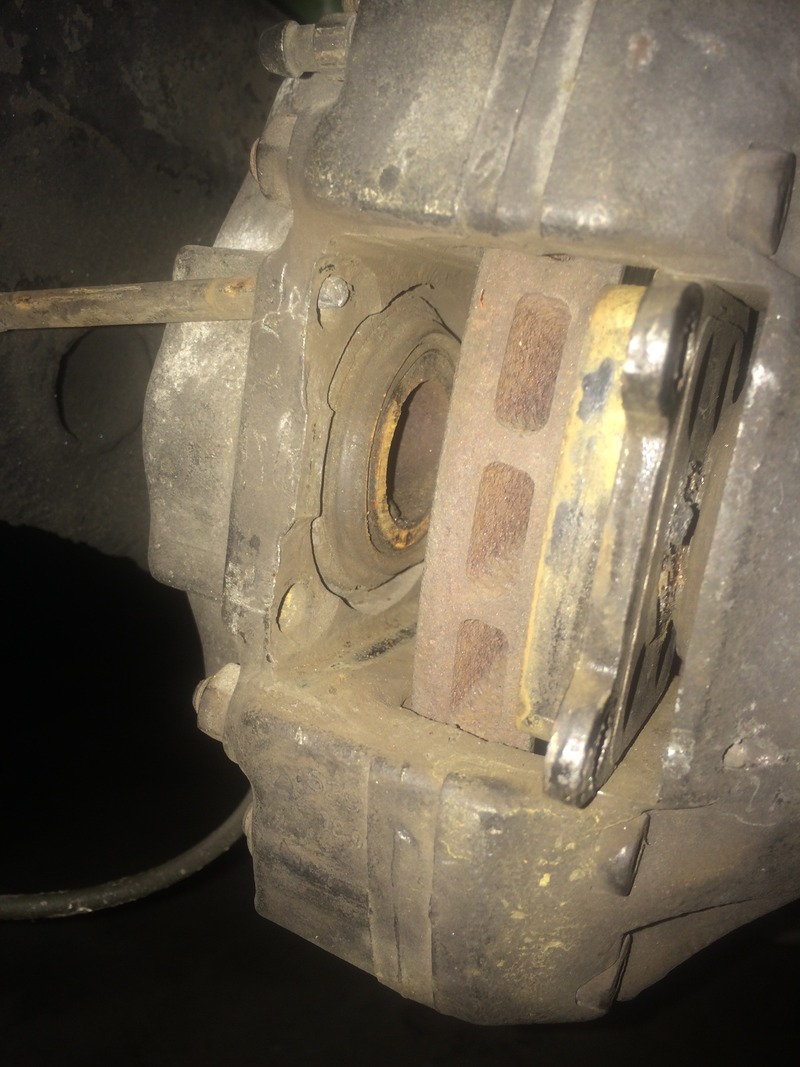john77
Aug 8 2015, 03:28 PM
About a month ago something in the rear of my car started making this high-pitched squeaking, metal on metal noise when I was reversing. Not constantly, but like something turning was binding and releasing, binding and releasing. I only had the rear bearings replaced 6 months ago, so i hoped it wasn't that.
With the car up on stands and the rear wheels removed I've isolated it to the driver's side rear wheel. If I turn the rotor by hand it rotates freely and then gets really hard to rotate, and then gets easy, and so on.
My first guess is that somehow I've warped the rotor. Does that sound right? I've never tracked the car, but I do ax it. Or could it be something else? I have the 5 lug conversion, so I believe they're off a 911.

porschetub
Aug 8 2015, 03:44 PM
QUOTE(john77 @ Aug 9 2015, 09:28 AM)

About a month ago something in the rear of my car started making this high-pitched squeaking, metal on metal noise when I was reversing. Not constantly, but like something turning was binding and releasing, binding and releasing. I only had the rear bearings replaced 6 months ago, so i hoped it wasn't that.
With the car up on stands and the rear wheels removed I've isolated it to the driver's side rear wheel. If I turn the rotor by hand it rotates freely and then gets really hard to rotate, and then gets easy, and so on.
My first guess is that somehow I've warped the rotor. Does that sound right? I've never tracked the car, but I do ax it. Or could it be something else? I have the 5 lug conversion, so I believe they're off a 911.

Take the caliper off and disconnent the axle and check the feel of the bearing ,AX puts a lot of strain on them,if thats ok get the rotors resurfaced.
john77
Aug 8 2015, 04:16 PM
[/quote]
Take the caliper off and disconnent the axle and check the feel of the bearing ,AX puts a lot of strain on them,if thats ok get the rotors resurfaced.
[/quote]
Will do. I must have done 6 events tops since I had them done - they should last longer than that, right? Right now, with the calipers on, there's no play in them whatsoever.
PanelBilly
Aug 8 2015, 04:19 PM
and I have extra axles/cv s in the classifieds if you need them
Spoke
Aug 8 2015, 04:39 PM
Do you have a dial indicator gauge? This is very useful for measuring the run out of the rotor. With the wheel on, you would be able to tell if the bearing is bad. HF has one for $35.
Click to view attachment
stugray
Aug 8 2015, 05:05 PM
If the nut is not tighetened to full torque after the new bearings, it can ruin the new bearings.
Or if the car is moved on the new bearings prior to having the nut torqued..
porschetub
Aug 8 2015, 05:05 PM
[quote name='john77' date='Aug 9 2015, 10:16 AM' post='2220716']
[/quote]
Take the caliper off and disconnent the axle and check the feel of the bearing ,AX puts a lot of strain on them,if thats ok get the rotors resurfaced.
[/quote]
Will do. I must have done 6 events tops since I had them done - they should last longer than that, right? Right now, with the calipers on, there's no play in them whatsoever.
[/quote]
Thats not a lot of time on the bearing for sure,certainly worth checking to start with .
The rotors need only the smallest amount of ''runout '' to cause issues,they don't always wear evenly.
zambezi
Aug 8 2015, 05:38 PM
Are you running the 911 parking brake shoes. If so it's possible something in there is rubbing or out of wack.
Dave_Darling
Aug 8 2015, 05:54 PM
Pull the pads out and see if the noise continues. If so, inspect where the rotor goes through the caliper. Might be the edge of the rotor rubbing on the bridge of the caliper; this happens when you use Six rotors (solid) with -4 calipers. Might also be happening with your mix of parts.
--DD
porschetub
Aug 8 2015, 06:17 PM
QUOTE(stugray @ Aug 9 2015, 11:05 AM)

If the nut is not tighetened to full torque after the new bearings, it can ruin the new bearings.
Or if the car is moved on the new bearings prior to having the nut torqued..
Exactly,had the same issue with my own car,scrapping noise went away when I torqued the nut up properly ,it wasn't really that loose maybe 180ft/lbs,took it up to torque (217 ft/lbs ?)and all was good.
Also check the caliper is done up tight on the trailing arm.
My car isn't running

but I found this issue when pushing the engineless body

.
Another thing for the OP is check the surface between the rotor and the axle stub,have seen rust build-up cause run-out,my old Golf GTI had that issue,good luck.
mgp4591
Aug 8 2015, 07:07 PM
I can see the wear pattern in your rotor from your picture- your rotor is warped. See the polished part on the outer face and then also the untouched part that is directly up from the rotor hat in your pic? That's the part that isn't making as much contact so it has less drag. If you've got a dial indicator (a very good idea anyway for checking not only rotor runout but suspension wear as well amongst other things) you'd see a difference as you spin the rotor. You may have a sticking piston or a piece of debris holding the pad against the rotor causing excess heat from constant contact causing your warpage problem. Another opinion- ask Mr. Shea, he's the expert.
john77
Aug 8 2015, 08:57 PM
QUOTE(Spoke @ Aug 8 2015, 03:39 PM)

Do you have a dial indicator gauge? This is very useful for measuring the run out of the rotor. With the wheel on, you would be able to tell if the bearing is bad. HF has one for $35.
Click to view attachmentThanks for all the suggestions. I have to pull the CV joints to replace the diff shaft seals (this is possible, right?) as my tranny is leaking like crazy since I changed the oil, so I guess this can become a 'while I'm in there' job.
Spoke, I have no idea what this is, but I want one. What is it? Scratch that, I'll google it.
Spoke
Aug 8 2015, 09:17 PM
QUOTE(john77 @ Aug 8 2015, 10:57 PM)

Spoke, I have no idea what this is, but I want one. What is it? Scratch that, I'll google it.
I bought one like shown for my 1996 Audi A6 when I bent all 4 wheels on various potholes in PA and NJ. On one particular pothole on RT78 outside Newark not only did I bend a rim, it blew the tire out.
It's basically a very sensitive ruler. Attach it to the vehicle and put the dial on the rotor or rim. Spin the wheel and watch the gauge. If no movement, the item is true. If the gauge jumps wildly then the item is out of round. Easy to see if your rotor is true.
Found on my 914 front end with '73 911 front end the new rotor was not true. Had to file the attachment face of the rotor until I observed acceptable run out.
Krieger
Aug 9 2015, 08:19 AM
QUOTE(Dave_Darling @ Aug 8 2015, 04:54 PM)

Pull the pads out and see if the noise continues. If so, inspect where the rotor goes through the caliper. Might be the edge of the rotor rubbing on the bridge of the caliper; this happens when you use Six rotors (solid) with -4 calipers. Might also be happening with your mix of parts.
--DD

I had this problem on one side, but not the other. Just loosed rotor and move a little. Check both top and bottom of rotor for clearance. I think I have about 3mm on each side.
john77
Aug 9 2015, 07:35 PM
This afternoon, I removed the cv joints/axle (I was replacing the diff shaft seal so had to do this anyway) and the brake disc continued to stick. So I pulled the brake pads too and then it stopped. No scraping at all. So it's not touching the caliper. With the pads removed, there's no play in the bearings either.
I have a dial indicator gauge on order, but it seems like everything is pointing to the disc being warped. Assuming it is that, for now, should any machine shop be able correct it? I'm guessing there's minimum thickness it can be taken down to before it's junk and I'd need to buy a new disc, right?
Dave_Darling
Aug 9 2015, 09:52 PM
The minimum thickness should be stamped on the edge of the rotor somewhere. Turning the rotor will probably help.
You may have uneven pad material deposition on the rotor. Not sure exactly how to deal with that, if scotch-brite or steel wool or sanding would be able to do it or not. Eric Shea may have more ideas; he knows the brakes on these cars very well. (Despite his and my disagreement elsewhere on the board!

)
--DD
john77
Aug 26 2015, 10:11 PM
My new dial indicator informs me the rotor is warped. I think the cause of it may be that the outer piston is sticking. An article on pelican about replacing brake pads said to push the piston back in with a wooden stick, but no matter how hard I press it the piston will not budge. Should it be sticking out of the caliper this far?

stugray
Aug 27 2015, 11:22 AM
Stupid question, but why cant I see a E-brake lever arm in the pic?
I dont see the cover for the outer adjuster screw either.
Rears requires you to turn the adjuster screw to retract the pistons.
From the limited pics those look like front calipers.
RoadGlue
Aug 27 2015, 12:23 PM
QUOTE(stugray @ Aug 27 2015, 10:22 AM)

Stupid question, but why cant I see a E-brake lever arm in the pic?
I dont see the cover for the outer adjuster screw either.
Rears requires you to turn the adjuster screw to retract the pistons.
From the limited pics those look like front calipers.
Vented rotors too. Looks like 911 M-calipers (I think) with no e-brake as they're normally mounted on the front. Bring a rock.
john77
Aug 27 2015, 12:27 PM
QUOTE(stugray @ Aug 27 2015, 10:22 AM)

Stupid question, but why cant I see a E-brake lever arm in the pic?
I dont see the cover for the outer adjuster screw either.
Rears requires you to turn the adjuster screw to retract the pistons.
From the limited pics those look like front calipers.
They're rear 911 m-calipers, so no e-brake. Sorry, completely forgot I asked about the calipers in another thread, not this one.


RoadGlue
Aug 27 2015, 12:28 PM
QUOTE(john77 @ Aug 27 2015, 11:27 AM)

QUOTE(stugray @ Aug 27 2015, 10:22 AM)

Stupid question, but why cant I see a E-brake lever arm in the pic?
I dont see the cover for the outer adjuster screw either.
Rears requires you to turn the adjuster screw to retract the pistons.
From the limited pics those look like front calipers.
They're rear 911 m-calipers, so no e-brake.
Thanks!
stugray
Aug 27 2015, 01:14 PM
QUOTE(john77 @ Aug 27 2015, 12:27 PM)

QUOTE(stugray @ Aug 27 2015, 10:22 AM)

Stupid question, but why cant I see a E-brake lever arm in the pic?
I dont see the cover for the outer adjuster screw either.
Rears requires you to turn the adjuster screw to retract the pistons.
From the limited pics those look like front calipers.
They're rear 911 m-calipers, so no e-brake. Sorry, completely forgot I asked about the calipers in another thread, not this one.
Then you should be able to get the pistons to move using a small C-clamp.
I just rebuilt a bunch of 914 Early front calipers to install on my race car in the rear.
It is very simple and if you dont feel the need to replate (or paint) the calipers, you can rebuild a pair in an afternoon.
It takes longer to take them apart and get the pistons out then to put the new parts in and put them back on the car.
john77
Aug 27 2015, 04:47 PM
QUOTE(stugray @ Aug 27 2015, 12:14 PM)

QUOTE(john77 @ Aug 27 2015, 12:27 PM)

QUOTE(stugray @ Aug 27 2015, 10:22 AM)

Stupid question, but why cant I see a E-brake lever arm in the pic?
I dont see the cover for the outer adjuster screw either.
Rears requires you to turn the adjuster screw to retract the pistons.
From the limited pics those look like front calipers.
They're rear 911 m-calipers, so no e-brake. Sorry, completely forgot I asked about the calipers in another thread, not this one.
Then you should be able to get the pistons to move using a small C-clamp.
I just rebuilt a bunch of 914 Early front calipers to install on my race car in the rear.
It is very simple and if you dont feel the need to replate (or paint) the calipers, you can rebuild a pair in an afternoon.
It takes longer to take them apart and get the pistons out then to put the new parts in and put them back on the car.
Thanks Stu. I think I'm going to go the whole way and get them replated with zinc - my friend runs a shop so he said I can throw them in with his next batch of stuff. Are the 914 fronts the same in that you need to use compressed air to get the pistons out?
stugray
Aug 27 2015, 04:56 PM
QUOTE(john77 @ Aug 27 2015, 04:47 PM)

Thanks Stu. I think I'm going to go the whole way and get them replated with zinc - my friend runs a shop so he said I can throw them in with his next batch of stuff. Are the 914 fronts the same in that you need to use compressed air to get the pistons out?
If you want to do them yourself read the tech articles at PMBPerformance.
http://www.pmbperformance.com/brakehowto.htmlI get the pistons out using a block of wood in the slot between the halves where the rotor goes.
Blow one out carefully by using paint stir sticks as spacers removing them as you go.
Once the first one pops out, put it back in gently and shim with the sticks.
Then keep going until you blow the other out.
NEVER use the air method without restricting the piston motion mechanically.
Just a couple of PSI will launch one across the garage, and you might need 100 PSI to free a stubborn piston.
john77
Aug 27 2015, 06:39 PM
QUOTE(stugray @ Aug 27 2015, 03:56 PM)

QUOTE(john77 @ Aug 27 2015, 04:47 PM)

Thanks Stu. I think I'm going to go the whole way and get them replated with zinc - my friend runs a shop so he said I can throw them in with his next batch of stuff. Are the 914 fronts the same in that you need to use compressed air to get the pistons out?
If you want to do them yourself read the tech articles at PMBPerformance.
http://www.pmbperformance.com/brakehowto.htmlI get the pistons out using a block of wood in the slot between the halves where the rotor goes.
Blow one out carefully by using paint stir sticks as spacers removing them as you go.
Once the first one pops out, put it back in gently and shim with the sticks.
Then keep going until you blow the other out.
NEVER use the air method without restricting the piston motion mechanically.
Just a couple of PSI will launch one across the garage, and you might need 100 PSI to free a stubborn piston.
Thanks Stu, that's an awesome write up.
This is a "lo-fi" version of our main content. To view the full version with more information, formatting and images, please
click here.




